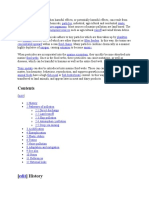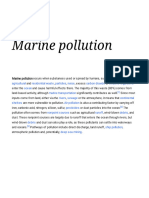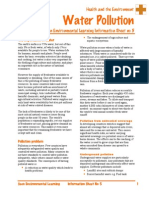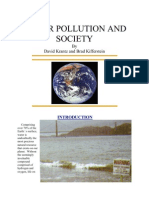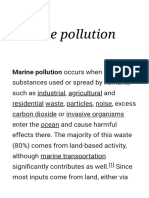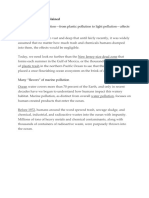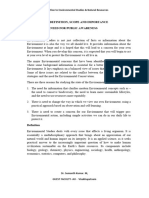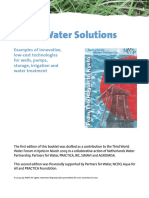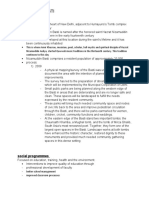0 ratings0% found this document useful (0 votes)
27 viewsAymane El Ansari-Ocean Pollution
Aymane El Ansari-Ocean Pollution
Uploaded by
Aymane El AnsariOcean pollution is a serious problem that threatens marine life and humans. The major causes are urban, industrial, and agricultural waste entering oceans from inadequate waste management systems. Pollution enters oceans directly through sewage discharge, toxic chemicals from industries, land runoff, oil spills from ships, and ocean mining activities. Potential solutions approved by the EU include banning certain single-use plastics, applying the polluter pays principle to industries like tobacco, setting targets to collect 90% of plastic bottles by 2029, and increasing recycled content in plastic bottles.
Copyright:
© All Rights Reserved
Available Formats
Download as PDF, TXT or read online from Scribd
Aymane El Ansari-Ocean Pollution
Aymane El Ansari-Ocean Pollution
Uploaded by
Aymane El Ansari0 ratings0% found this document useful (0 votes)
27 views7 pagesOcean pollution is a serious problem that threatens marine life and humans. The major causes are urban, industrial, and agricultural waste entering oceans from inadequate waste management systems. Pollution enters oceans directly through sewage discharge, toxic chemicals from industries, land runoff, oil spills from ships, and ocean mining activities. Potential solutions approved by the EU include banning certain single-use plastics, applying the polluter pays principle to industries like tobacco, setting targets to collect 90% of plastic bottles by 2029, and increasing recycled content in plastic bottles.
Original Description:
fzfz
Copyright
© © All Rights Reserved
Available Formats
PDF, TXT or read online from Scribd
Share this document
Did you find this document useful?
Is this content inappropriate?
Ocean pollution is a serious problem that threatens marine life and humans. The major causes are urban, industrial, and agricultural waste entering oceans from inadequate waste management systems. Pollution enters oceans directly through sewage discharge, toxic chemicals from industries, land runoff, oil spills from ships, and ocean mining activities. Potential solutions approved by the EU include banning certain single-use plastics, applying the polluter pays principle to industries like tobacco, setting targets to collect 90% of plastic bottles by 2029, and increasing recycled content in plastic bottles.
Copyright:
© All Rights Reserved
Available Formats
Download as PDF, TXT or read online from Scribd
Download as pdf or txt
0 ratings0% found this document useful (0 votes)
27 views7 pagesAymane El Ansari-Ocean Pollution
Aymane El Ansari-Ocean Pollution
Uploaded by
Aymane El AnsariOcean pollution is a serious problem that threatens marine life and humans. The major causes are urban, industrial, and agricultural waste entering oceans from inadequate waste management systems. Pollution enters oceans directly through sewage discharge, toxic chemicals from industries, land runoff, oil spills from ships, and ocean mining activities. Potential solutions approved by the EU include banning certain single-use plastics, applying the polluter pays principle to industries like tobacco, setting targets to collect 90% of plastic bottles by 2029, and increasing recycled content in plastic bottles.
Copyright:
© All Rights Reserved
Available Formats
Download as PDF, TXT or read online from Scribd
Download as pdf or txt
You are on page 1of 7
Ocean Pollution
Report made by:Aymane El Ansari
Introduction:
The world today faces many challenges, one challenge that need
to be addressed is ocean pollution.
This phenomenon contributes to the death of precious marine
life, and threaten the lives of humans themselves in this report
we will discusses the causes,effect and potential solution to this
problem.
Causes:
The majority of marine pollution comes from urban, industrial
and agricultural pollution.
Urban pollution comes from coastal or riverine agglomerations
that do not have effective waste and wastewater collection and
reprocessing systems. The costs associated with this type of
installation require a certain level of wealth, which implies that
only advanced countries are able to acquire these
infrastructures, while in developing countries, the equipment
process is still under way. Between 4.8 and 12.7 million tonnes
of waste enter the oceans each year due to inadequate handling
and treatment of waste.
1. Sewage
Pollution can enter the ocean directly. Sewage or polluting
substances flow through sewage, rivers, or drainages directly
into the ocean. This is often how minerals and substances from
mining camps find their way into the ocean.
The release of other chemical nutrients into the ocean’s
ecosystem leads to reductions in oxygen levels, the decay of
plant life, a severe decline in the quality of the seawater itself.
As a result, all levels of oceanic life, plants and animals, are
highly affected.
2. Toxic Chemicals From Industries
Industrial and agricultural waste is another most common form
of wastes that are directly discharged into the oceans, resulting
in ocean pollution. The dumping of toxic liquids in the ocean
directly affects the marine life as they are considered hazardous
and secondly, they raise the temperature of the ocean, known
as thermal pollution, as the temperature of these liquids is quite
high. Animals and plants that cannot survive at higher
temperatures eventually perish.
3. Land Runoff
Land runoff is another source of pollution in the ocean. This
occurs when water infiltrates the soil to its maximum extent and
the excess water from rain, flooding or melting flows over the
land and into the ocean.
4. Large Scale Oil Spills
Ship pollution is a huge source of ocean pollution, the most
devastating effect of which is oil spills. Crude oil lasts for years in
the sea and is extremely toxic to marine life, often suffocating
marine animals to death once it entraps them. Crude oil is also
extremely difficult to clean up, unfortunately meaning that when
it is split; it is usually there to stay.
5. Ocean Mining
Ocean mining in the deep sea is yet another source of ocean
pollution. Ocean mining sites drilling for silver, gold, copper,
cobalt, and zinc create sulfide deposits up to three and a half
thousand meters down into the ocean.
Solution:
A ban on single-use plastics for which other alternatives are
available such as: cutlery (knives, spoons, forks, chopsticks) and
plates, cotton swabs, straws, touillettes and balloon stems. MEPs
added oxo-plastics and some polystyrenes were approved by
MEPs.
Other measures were also approved during a vote on March 27
in Strasbourg. Here they are :Reinforced application of the
"polluter pays" principle, among others for the tobacco industry,
by making producers more responsible. This new regime will also
apply to fishing gear, to ensure that manufacturers, not
fishermen, bear the costs of collecting nets lost at sea.
Targets to collect 90% of plastic bottles by 2029 (for example, by
introducing deposit systems).
Plastic bottles will need to be at least 25% recycled content by
2025, and 30% by 2030.
Provide labeling requirements for sanitary napkins and tampons
as well as for cigarette filters, plastic cups, wet wipes to inform
consumers of their negative environmental impact.
Continue to educate on the importance of recycling.
You might also like
- Science 10 Q4 Module 5Document23 pagesScience 10 Q4 Module 5Dennis Douglas Alo Jr.No ratings yet
- Grandparent Management Guide PDFDocument54 pagesGrandparent Management Guide PDFFaisal MohommadNo ratings yet
- Trabajo Escrito Oceano Ingles DanielaDocument16 pagesTrabajo Escrito Oceano Ingles DanieladanielaNo ratings yet
- Environemnt CompleteDocument24 pagesEnvironemnt CompletePranav NNo ratings yet
- Slide Zoom PowerPoint Template by One SkillDocument21 pagesSlide Zoom PowerPoint Template by One SkillArushi singhNo ratings yet
- Planets in HosuesDocument7 pagesPlanets in HosuesDinesh TomarNo ratings yet
- Environmental Studies: Submitted By-Arushi Singh Skand Tanu Sharma Uday Submitted To - Mrs. Nidhi SachdevaDocument20 pagesEnvironmental Studies: Submitted By-Arushi Singh Skand Tanu Sharma Uday Submitted To - Mrs. Nidhi SachdevaARUSHI SINGHNo ratings yet
- Marine PollutionDocument18 pagesMarine PollutionКристина ОкуловскаяNo ratings yet
- Report of Sea Pollution and Its PreventionDocument20 pagesReport of Sea Pollution and Its Preventionnamemamun75% (4)
- Oceans and Sea PollutionDocument5 pagesOceans and Sea PollutionDoru TărcăuNo ratings yet
- What Is Ocean Pollution?: How Much Money Can A Solar Roof Save You in Malaysia?Document7 pagesWhat Is Ocean Pollution?: How Much Money Can A Solar Roof Save You in Malaysia?Jega SkyNo ratings yet
- Marine PollutionDocument3 pagesMarine Pollutionsia.aaaaaaaaaa1No ratings yet
- Marine Pollution Occurs When Harmful EffectsDocument13 pagesMarine Pollution Occurs When Harmful EffectsGaurav ThakurNo ratings yet
- History: Marine Pollution Occurs When Harmful Effects, or Potentially Harmful Effects, Can Result FromDocument12 pagesHistory: Marine Pollution Occurs When Harmful Effects, or Potentially Harmful Effects, Can Result Fromsachin5252No ratings yet
- Marine PollutionDocument13 pagesMarine PollutionLiliana Lambruschini100% (1)
- Marine Pollution - Anushka SinghDocument14 pagesMarine Pollution - Anushka SinghAnushkaNo ratings yet
- Environmental Science and Engineering: 20BSCY201Document13 pagesEnvironmental Science and Engineering: 20BSCY201HARSHITHA M SEC 2020No ratings yet
- UNIT 13 - Marine EnvironmentDocument7 pagesUNIT 13 - Marine EnvironmentNakiri AliceNo ratings yet
- LAW - 904 (Assignment)Document9 pagesLAW - 904 (Assignment)Mostafa ShahriarNo ratings yet
- marine PollutionDocument4 pagesmarine PollutionkakenNo ratings yet
- MARINE POLLUTION Version FinaleDocument12 pagesMARINE POLLUTION Version FinaleMarcya MadzoundouNo ratings yet
- Marine PollutionDocument16 pagesMarine PollutionChandrima MannaNo ratings yet
- Maritime Pollution - OriginalDocument16 pagesMaritime Pollution - OriginalasifsabirhussainNo ratings yet
- Marine PollutionDocument12 pagesMarine PollutionSandyNo ratings yet
- Non TechnicalDocument20 pagesNon TechnicalAngiras SureshNo ratings yet
- ME All Year study/ME 2year 1st sem/ES/MArine PollutionDocument11 pagesME All Year study/ME 2year 1st sem/ES/MArine PollutionmanashNo ratings yet
- SC Water PollutionDocument16 pagesSC Water Pollutionnor syazwani67% (3)
- Marine Pollution: Jannatul FerdousDocument20 pagesMarine Pollution: Jannatul FerdousNazmoon NaharNo ratings yet
- Mid-Term QDocument10 pagesMid-Term QHany EmadNo ratings yet
- The Causes and Effects of Marine PollutionDocument4 pagesThe Causes and Effects of Marine PollutionAubrey Marie VillamorNo ratings yet
- Thesis Statement On Ocean PollutionDocument7 pagesThesis Statement On Ocean Pollutionfczeohief100% (1)
- DT Assgn2Document10 pagesDT Assgn2xyzNo ratings yet
- Marine Pollution - WikipediaDocument34 pagesMarine Pollution - WikipediaAhfrin JNo ratings yet
- Assignment On Marine Pollution: Environmental EducationDocument12 pagesAssignment On Marine Pollution: Environmental EducationJyotishmoi BoraNo ratings yet
- Marine ProblemsDocument4 pagesMarine ProblemsPhilip Bustos100% (1)
- DeepakDocument18 pagesDeepakkaransharma7567No ratings yet
- Sewage and Other Water PollutantsDocument5 pagesSewage and Other Water PollutantsTSL10621 Andrea Sia Jia WeiNo ratings yet
- Ocean PollutionDocument3 pagesOcean Pollutionsameekshamane29No ratings yet
- Water PollutionDocument5 pagesWater PollutionFahiem ChaucerNo ratings yet
- PowerPoint Presentation of Water Polution and Its PreventionDocument24 pagesPowerPoint Presentation of Water Polution and Its PreventionAbi Havoc100% (2)
- Water Pollution and SocietyDocument12 pagesWater Pollution and SocietyRaja_ne23100% (1)
- Marine Pollution - WikipediaDocument142 pagesMarine Pollution - WikipediaCharls Aron ReyesNo ratings yet
- Petroleum (Oil) PollutionDocument2 pagesPetroleum (Oil) PollutionMohammad Zamir TaqwaNo ratings yet
- Pollution: Cresar 2016 / Casa Luisa, Gen Eral Santos City By: Engr - Waldemar G. Soguilon, Reb / Rea / EnpDocument71 pagesPollution: Cresar 2016 / Casa Luisa, Gen Eral Santos City By: Engr - Waldemar G. Soguilon, Reb / Rea / EnpLaw_PortalNo ratings yet
- A Wide Range of Pollution-From Plastic Pollution To Light Pollution-Affects Marine EcosystemsDocument72 pagesA Wide Range of Pollution-From Plastic Pollution To Light Pollution-Affects Marine EcosystemsPranav NNo ratings yet
- Marine Pollution-Documentary Script: October 2005Document9 pagesMarine Pollution-Documentary Script: October 2005Rubyjayne Kate ANINONNo ratings yet
- 15876184390EVSAECC01 Water PollutionDocument8 pages15876184390EVSAECC01 Water Pollutionsharmaryan0805No ratings yet
- What Is Water PollutionDocument11 pagesWhat Is Water Pollutionmuskaan.kukrejaNo ratings yet
- Marine PollutionDocument7 pagesMarine Pollutionsumanth100% (1)
- EsDocument14 pagesEstalhadaudzai043No ratings yet
- How Water Pollution Effects Marine LifeDocument2 pagesHow Water Pollution Effects Marine Lifegaraamohamed7No ratings yet
- Lecture 1Document8 pagesLecture 1JosephNo ratings yet
- Water Pollution and ControlDocument35 pagesWater Pollution and ControlSanthilal S PillaiNo ratings yet
- Anwesha - Nimay Kumar TOPIC: Life Below Water SUB TOPIC: Reduce Marine Pollution Topics To Be CoveredDocument2 pagesAnwesha - Nimay Kumar TOPIC: Life Below Water SUB TOPIC: Reduce Marine Pollution Topics To Be CoveredNimay KumarNo ratings yet
- Bab Ii Pembahasan: Pencemaran Laut Didefinisikan Sebagai Peristiwa Masuknya Partikel Kimia, LimbahDocument18 pagesBab Ii Pembahasan: Pencemaran Laut Didefinisikan Sebagai Peristiwa Masuknya Partikel Kimia, LimbahhadrimankhairNo ratings yet
- Name: Areen EspaniolyDocument12 pagesName: Areen EspaniolyareenNo ratings yet
- Pollution : Problems Made by Man - Nature Books for Kids | Children's Nature BooksFrom EverandPollution : Problems Made by Man - Nature Books for Kids | Children's Nature BooksNo ratings yet
- Mare Plasticum - The Plastic Sea: Combatting Plastic Pollution Through Science and ArtFrom EverandMare Plasticum - The Plastic Sea: Combatting Plastic Pollution Through Science and ArtMarilena Streit-BianchiNo ratings yet
- The Little Book of Going Green: Really Understand Climate Change, Use Greener Products, Adopt a Tree, Save Water, and Much More!From EverandThe Little Book of Going Green: Really Understand Climate Change, Use Greener Products, Adopt a Tree, Save Water, and Much More!Rating: 1 out of 5 stars1/5 (1)
- B01 - CM1 - P1 - C45 - KSV - S19 - 0001 - 001 - B - O - PAINTING PROCEDURE 1B (Revisado)Document18 pagesB01 - CM1 - P1 - C45 - KSV - S19 - 0001 - 001 - B - O - PAINTING PROCEDURE 1B (Revisado)AirtonNo ratings yet
- Técnicas Simplificadas de Tratamento de ÁguaDocument14 pagesTécnicas Simplificadas de Tratamento de ÁguaGabriel Marques100% (1)
- T006S52PDocument12 pagesT006S52PdiegoNo ratings yet
- Boulay Chapter 3Document5 pagesBoulay Chapter 3Sheldon MillerNo ratings yet
- Calorimetry ProblemsDocument2 pagesCalorimetry ProblemsSid Damien TanNo ratings yet
- Cat 966FDocument15 pagesCat 966FMohammed NADJIB DEBBALNo ratings yet
- Chapter 1 Evs NotesDocument42 pagesChapter 1 Evs NotesNaruto KunNo ratings yet
- PART1Document98 pagesPART1Raphael CajucomNo ratings yet
- Product Information Flyer: CIMSTAR® 10-85VGDocument2 pagesProduct Information Flyer: CIMSTAR® 10-85VGsobheysaidNo ratings yet
- PUPSITDocument43 pagesPUPSITAlessandro Chreim100% (1)
- NWP1 - Smart Water SolutionsDocument48 pagesNWP1 - Smart Water SolutionsJuan Carlos ReyesNo ratings yet
- Method of Test For Bulk Relative Density of Compacted Bituminous MixturesDocument3 pagesMethod of Test For Bulk Relative Density of Compacted Bituminous Mixturesming_zhu10No ratings yet
- PNTC Colleges: Activity SheetDocument3 pagesPNTC Colleges: Activity SheetMarianne Jubille CataquisNo ratings yet
- Nalco 8539: Product Bulletin Cooling Water Chemicals Closed System InhibitorDocument1 pageNalco 8539: Product Bulletin Cooling Water Chemicals Closed System InhibitorChanBoonChew100% (1)
- Nizamuddin BastiDocument5 pagesNizamuddin Bastiradhika goelNo ratings yet
- Classify T: Detailed Lesson Plan in English - Grade 7Document23 pagesClassify T: Detailed Lesson Plan in English - Grade 7Diana arcangelNo ratings yet
- Canada Civil Engineering Syllabus PDFDocument13 pagesCanada Civil Engineering Syllabus PDFpremsubha100% (1)
- Role of AI in Climate ChangeDocument3 pagesRole of AI in Climate ChangeInternational Journal of Innovative Science and Research TechnologyNo ratings yet
- 26-Livid - Patricia CornwellDocument298 pages26-Livid - Patricia CornwellMarlie ProdehlNo ratings yet
- Work Procedure For Pre-CommissioningDocument19 pagesWork Procedure For Pre-CommissioningTrustEmma100% (3)
- Field Sampling Procedure ManualDocument574 pagesField Sampling Procedure Manualpetrus01idNo ratings yet
- Groundwater Quality Status Using Water Quality Index in Amalner Town MaharashtraDocument5 pagesGroundwater Quality Status Using Water Quality Index in Amalner Town Maharashtrasunaina agarwalNo ratings yet
- Material Technical Data Sheet: A-SPE Marking TapesDocument2 pagesMaterial Technical Data Sheet: A-SPE Marking TapesAkhmad HarisNo ratings yet
- Nalco ACT: Boiler Water Operator Training NotesDocument4 pagesNalco ACT: Boiler Water Operator Training NotesSheikh Sahab100% (1)
- METSIM Value Functions & Other InformationDocument23 pagesMETSIM Value Functions & Other InformationjorgecatalinahuancaNo ratings yet
- Hand Dug Well Equipment PDFDocument39 pagesHand Dug Well Equipment PDFAnonymous swWVf3TW5ONo ratings yet
- Nordstrom Valves: Sealants and Sealant EquipmentDocument12 pagesNordstrom Valves: Sealants and Sealant EquipmentHrushikesh ReddyNo ratings yet
- Alkaline RoDocument24 pagesAlkaline Rovdefelipe8No ratings yet












